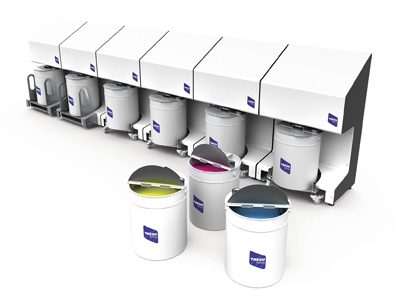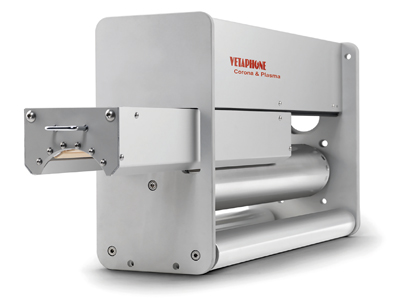Vetaphone’s VE1A corona treatment unit
It has been said many times before, the concept of flexography is simple, but it requires a large number of different components to achieve quality and consistent print. Michal Lodej looks at some of the many pieces of kit, gadgets and gizmos needed in a flexo print room.
Ink can often be a tricky commodity to handle. Every drop needs to be used to make production as profitable as possible. Along with its chambered doctor blades (which you can read about on p17-19) Tresu also offers its F10 iCon ink supply system for automated flow regulation.
Tresu’s F10 iCon ink supply system regulates ink flow, pressure and viscosity from the bucket, through to the chamber, to the press, maintaining constant, pre-set ink density values for complete production runs. When ink changes are required, the system carries out fast and thorough cleaning of the chamber automatically, and returns almost all unused contents to the bucket for reuse on subsequent jobs. With the F10 iCon, simultaneous ink change cycles on printing stations take a few minutes, delivering significant time and materials savings per job.

Tresu’s F10 iCon ink supply system
Tresu has many years’ experience in managing retrofitting programmes, where chamber doctor blades and ink supply systems are installed on flexo presses. Henrik Kristensen, vice president, Tresu Ancillary, commented, ‘Modernisation programmes, whether for inline, central impression or stack systems, can bring presses aged over 20 years to the latest standards of performance. Closed ink supply solutions available for just about all widths and anilox roll diameters, from label to corrugated converting. Installations bring enormous payback: predictable quality, better productivity with reduced setup times, assurance of a solvent-free working environment, higher ink yields, longer ink life and lower labour costs.’
Through thick and thin
While on the subject of ink, another important part of keeping it in good condition while on the press is viscosity control. Control systems
for ink, adhesives and varnishes, provide a means of measuring and controlling viscosity, usually by using vibration technology.
Gama supplies a wide range of products for the packaging and labels market, including the viscosity meters VIS G26 and G29. The company describes them as simple tools, compact and easy to use, that control ink viscosity, for both solvent-based and water-based inks, which are integrated in the pipe for the distribution of the ink from the container to the printing unit.
The VIS G26 is based on a principle of ink control through the vibration of a sensor, that when coming into contact with the ink softens its vibration and creates a wave that goes through the liquid.
The viscosity values are compared with the set up data and, for every variation, the operator can alter the formula of the ink/solvent which will automatically modify the percentage of solvent in the ink. The system will then provide the operator with a production report including viscosity, temperature, quantity and deviation of the solvent used.
Checking your tolerance
At the other end of the print run, when the ink has been laid and cured, it is the moment when you keep your fingers crossed that all the work in
pre-press has been successful, and that you have printed the colours you were aiming for.
To this end spectrophotometers are essential. They measure reflected or transmitted light across the visible spectrum and create a visual curve that describes a colour. This spectral data helps ensure colour is consistent across varying substrates and production processes.
X-Rite’s colour measurement solutions take into account the new business needs and dynamics of a global supply chain. Its spectrophotometers enable those in the printing, automotive, plastics and paint industries to understand, control, manage and communicate colour across their entire colour network.
Managing and understanding expectations on press all helps to avoid reprint and rework and achieve standards and tolerances.
A sphere spectrophotometer can measure metallic inks, printing over foil, and other highly glossy surfaces. They are versatile because they can measure colour without the impact of the substrate’s surface effects, and the measurement results are very close to what the human eye sees.
There are a number of different products available from X-rite such as the Ci7800 Benchtop, Ci7600 Benchtop and the Ci6x Handheld units.
The company also has instruments for smooth or matte surfaces. A 0º/45º spectrophotometer removes the gloss from the measurement dynamics to capture accurate colour values.
A multi-angle instrument is able to measure colours that shift when viewed from different angles, such as specialty coated pigments and paint finishes with special additives like mica, pearlescent materials, and ground-up seashells. The company’s multi-angle instruments are the MA98 Portable MA96 Portable.
Keeping it inline
Checking tolerances after the work is done is all very well but what if you can check for colour deviations while the job is running? Garafikontrol’s Chromalab is an inline spectrophotometer which provides real time measurement and colour correction on start-up and during production.
It can read from either dedicated colour patches or the image area itself and importantly it can provide real time colour measurements including spectral curves, ∆, LAB values, density and dot gain.
The unit itself uses a motorised traverse and can position itself on the colour bars or directly on selected areas of the image if required. When the measured data is out of specification to the master values, the data is sent to the ink room where a correction dose can be formulated to bring the colour back into tolerance.
Making it stick
If you print on plastic, which most of you do, then one of the most over looked parts of a flexo press is probably the corona treatment unit. Corona treatment is a high frequency discharge that increases the adhesion of a plastic surface. Getting a liquid to wet a material properly depends on the chemical nature of both the liquid and the substrate. Wetting is defined as the ratio between the surface energies of the liquid and substrate.
Corona treatment is necessary to obtain sufficient wetting and adhesion on plastic films or metallic foils before printing, laminating or coating.
There will be some new offers in this part of the market launched at the up coming Labelexpo Europe 2017. Ferrarini & Benelli is showing its new ET98 narrow web corona treatment station for the treatment of labels before printing. Different sizes are available and suitable for speed up to 300m/min.
Vetaphone will also be showing its system to handle today’s demanding applications in the narrow web market. It is equipped with iCorona technology and ceramic electrodes for treating conductive and non-conductive substrates, and quick change electrode cartridges for easy cleaning and maintenance as standard.
Read the full September issue of FlexoTech here. Subscribe to the magazine for free – register your details here.






